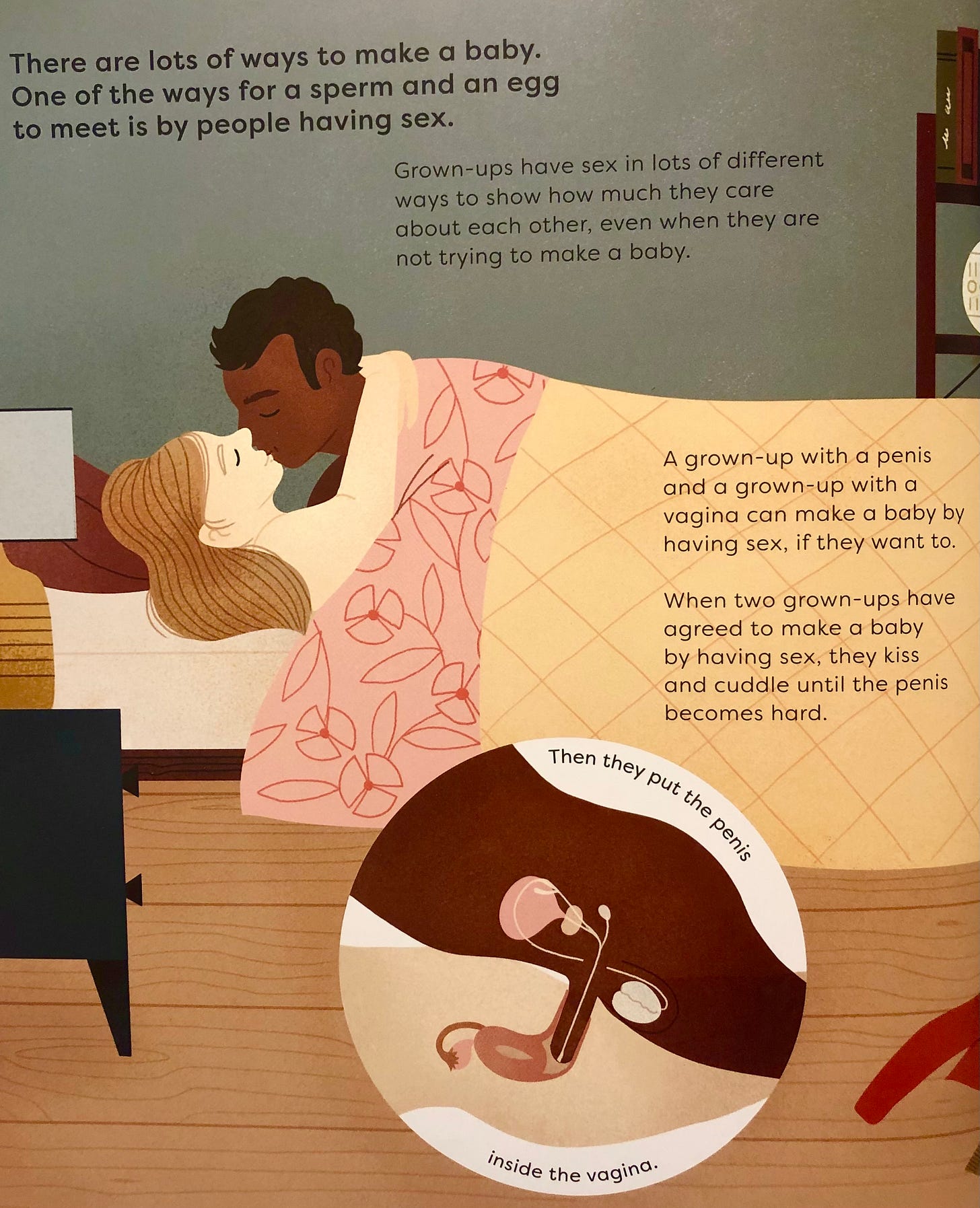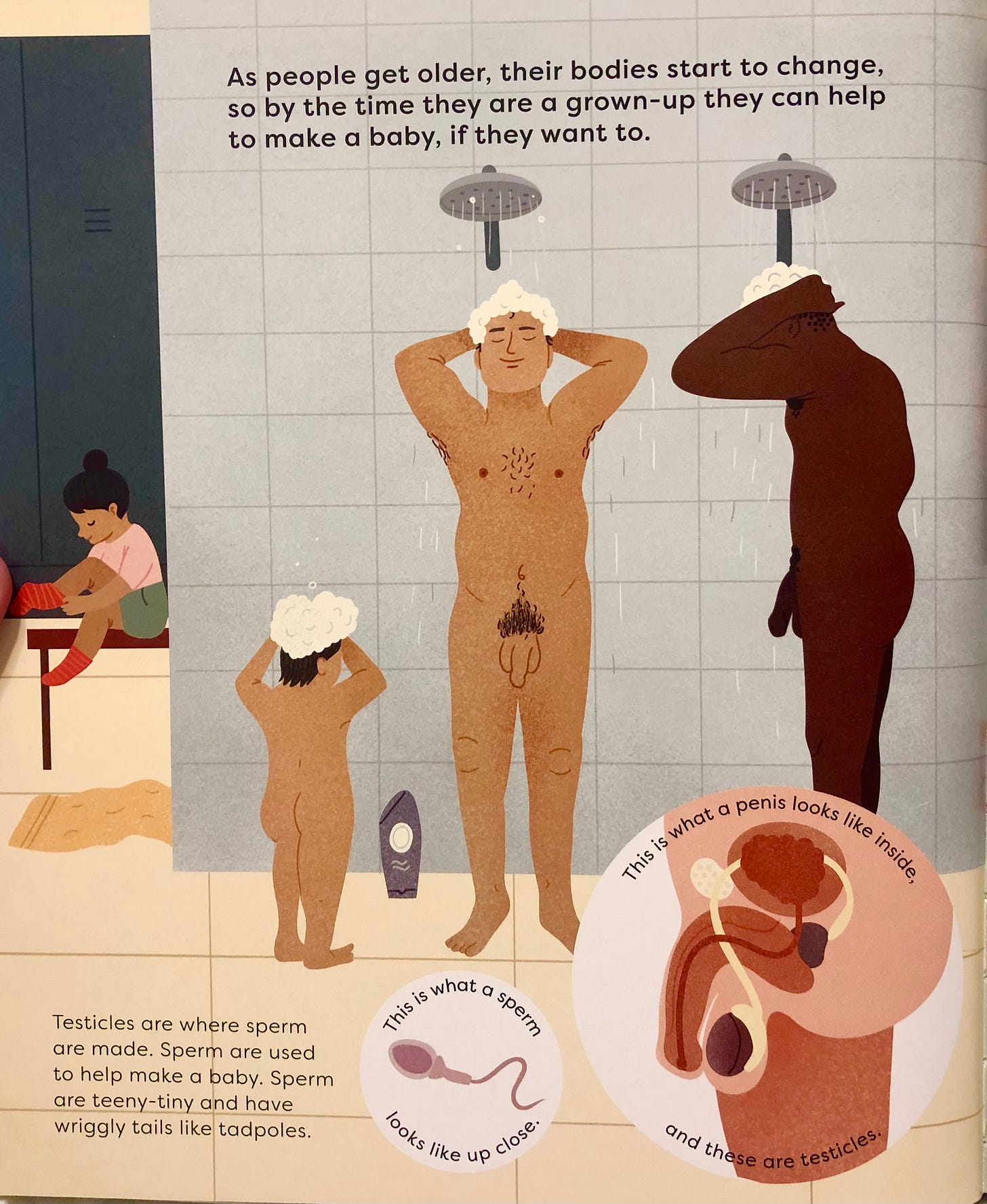Making a Baby by Rachel Greener and Clare Owen
Making a Baby is a descriptive book about, well, making babies. It’s a self-proclaimed “INCLUSIVE guide to how every family begins.” There are several things to commend about Making a Baby. It doesn’t mention abortions at all, and it does not shy away from calling humans in the womb babies. It has these definitions of boys and girls, implying that the feelings-based gender model is not approved of by the authors:
“A baby who has a penis and testicles is called a boy. The penis is used for peeing.”
“A baby who has a vulva, which is made up of lots of different parts, is called a girl.”
Finally, sex is always presented as something only grown-ups do. None of these are particularly praiseworthy, but when so many books are seeking to push lies in these areas, it’s notable to see some that hint at the truth.
The Issue with a Kids Book about Sex
The problem is that it is too descriptive, especially considering the fact that it is marketed to five to eight-year-olds. I wish there was a clear line between what is appropriate and what is not when it comes to children’s books. It is accurate to say, “One of the ways for a sperm and an egg to meet is by people having sex.” Although I tend to use more euphemistic language with my young kids, I understand why some want to use a more matter-of-fact approach. But do those kids need to know that, “Grown-ups have sex in lots of different ways to show how much they care about each other, even when they are not trying to make a baby?” Do they need to know that, “When two grown-ups have agreed to make a baby by having sex, they kiss and cuddle until the penis becomes hard. Then they put the penis inside the vagina?”
What is the line? I don’t think we need to resort to stork delivery when explaining where babies come from, but we also do not need to be so descriptive. Yes, kids are curious, but that does not mean that we need to be graphic. Children do not need to know about erections. Children do not need illustrations of a couple having sex, and another of a man’s penis going into a woman’s vagina. There may not be a clear line, but there is a line. This is clearly over that line:
The Illustrations
I have plenty of issues with the text in this book, but it is the illustrations that place it so clearly outside what is appropriate for a children’s book. In addition to the above, there are two images from a changing room and shower. In the men’s changing room, a young boy showers with two grown men, while a girl gets dressed in the background.
Five-year-olds do not need to see graphic illustrations of men’s penises. They do not need to have showering with grown men normalized. At that age, even a Vitruvian Man-style illustration would be a bit beyond the pale.
In the interest of fairness, here is the women’s changing room:
Gender Extremism
Despite the definitions of boy and girl in the early part of the book, Making a Baby does promote gender dysphoria. There are hints throughout the main part of the book, such as the “grown-up with a penis” nonsense with the sex illustration, but it is in a short Q&A section at the back of the book that the authors present it more fully:
“Some people grow up feeling that the biological sex they were given at birth is not their true sex, or that they don’t belong to either sex. And some choose to make changes as they get older1 to help the way they look on the outside match up with the way they feel on the inside.”
The use of the word “sex” in this paragraph is confusing for two reasons: it could be confusing for children who just learned about “having sex” a few pages earlier, and the word generally used her by gender extremists is “gender.” Separating sex and gender is one of their most foundational tenets, and it is baffling to see any intentional reason for this use of language unless the authors have decided to completely toss out the idea of meaningful biological differences between men and women.
Promotion of gender dysphoria can lead to depression, “gender-affirming” mutilation, and suicide. This isn’t just some little political disagreement between left and right; public libraries do not need to be providing different viewpoints on something this destructive.
Inclusion and Emphasis
While the “inclusive” statement from the cover of the book could be referring to the vague allusions to homosexuality thoughout or to the racial diversity of the people in the illustrations, but it seems that its primary meaning is to cover every possibility in the making of a baby. Some of these could be valuable for children, such as the discussion around adoption. There are also whole pages on surrogacy and in vitro fertilization, entirely unnecessary topics for children.2 There is also mention of intersex people. "Inclusive" here could just as easily say "encyclopedic," as the authors include every miniscule possibility without any of the art of editing to give a true picture.
In the Library
With the illustrations and the promotion of gender dysphoria, this book is clearly misclassified in my local public library. It should not be in the children’s section. But it really doesn’t need to be in the adult section either. A pornographic Where’s Spot? might be a novelty item for childish adults, but other than that, there is a complete mismatch between the appropriateness of the illustrations and reading level of the content. Making a Baby is like a pornographic Where’s Spot?. It is too adult for children, and too childish for adults. Its only proper home in a public library is the garbage bin.
“Older” here could just as well apply to older children and teenagers, so I’m not going to make much of this clarification.
I’m against surrogacy and IVF, but even for those who are not, is it really something children need to know about?







